How to hold a violin bow for beginners
If you want to become a better musician, play with a fuller, deeper sound, improve your playing and right-hand technique, learn to develop a more natural-feeling bow hold, you have to understand and learn how to hold a violin or viola bow properly. Many of my students improved their playing after adjusting their bow hold and bow arm movement. It is essential to understand the basic principles of the correct bow hold and how it can affect your playing.
How to hold a violin bow: Basics
One of the main keys to a proper violin bow hold is to maintain your right hand , wrist, and fingers relaxed. They should look like an extension of your arm, forming a horizontal line.
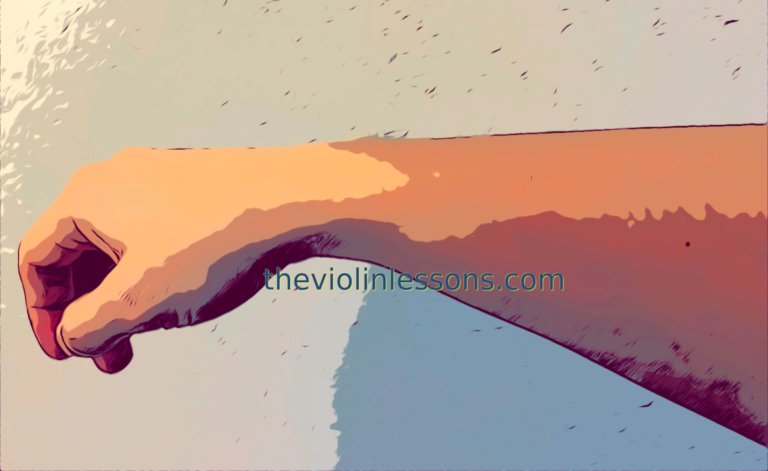
How to hold a violin bow:Thumb placement
Place your bent thumb under the wooden stick close to the frog (bottom part of the bow). Avoid placing it in the frog’s notch.
Your thumb should be bent and placed on its tip, between the bow hair and the stick, allowing it to support the bow so the bow can rest on your thumb.
Make sure your thumb always remains bent and rounded. Now you can take the tip of the bow in your left hand and check if your thumb supports the bow at the frog.
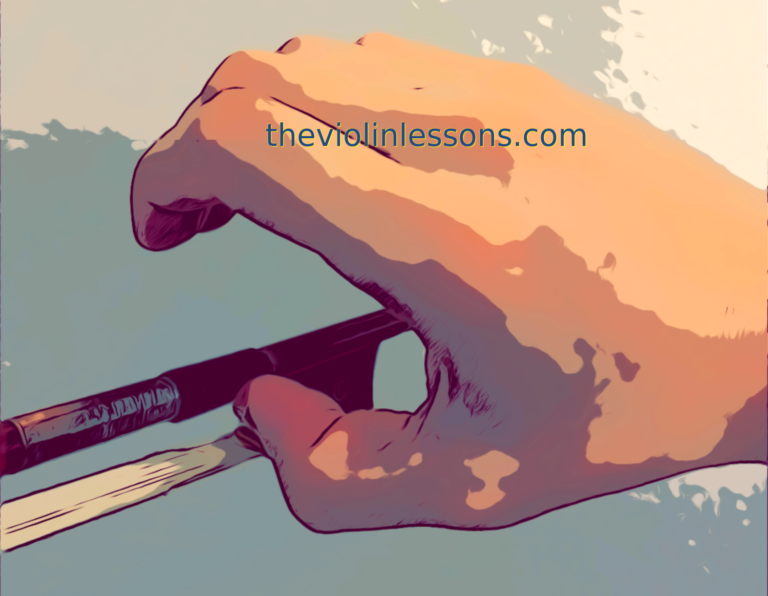
How to hold a violin bow: The middle and the thumb form a ring
When you feel that everything is working properly, take the bow in your left hand close to the frog and place the middle finger on the stick in front of your thumb.
As you can see, the middle finger and the thumb form a ring, which is very important in the bow hold. The thumb stays in front of the middle finger.
These are the main fingers that help us to guide the bow. You can press them on opposite sides of the bow and feel how tight they can be. Relax them to feel the difference between tension and relaxation.
Keep your middle finger relaxed and rounded, gently curved over the top of the bow stick, between the first and second knuckles.
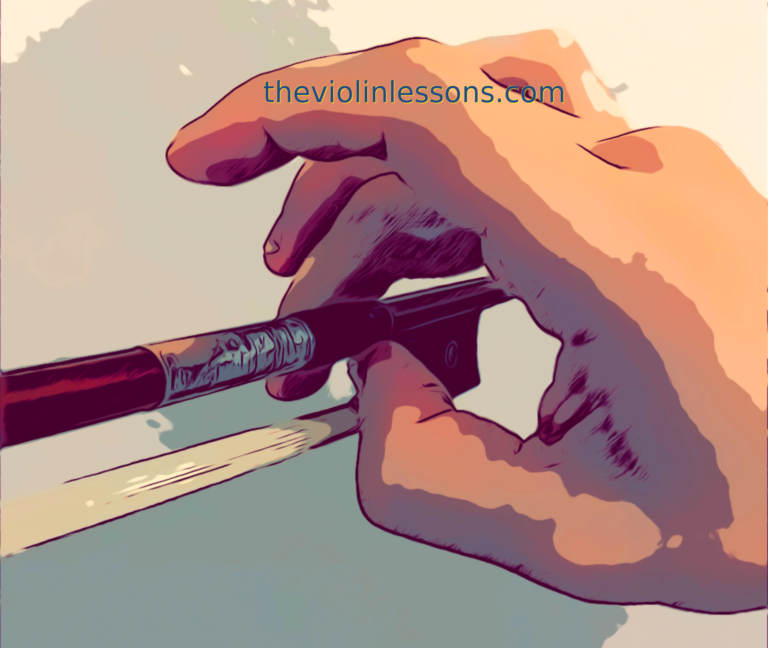
How to hold a violin bow: Place all fingers on the bow
When you start feeling more comfortable with the middle finger and the thumb, add the index finger, the ring finger, and the pinkie(the little finger) to the bow as well. Put them down on the bow stick and space them as evenly as possible. They form the same shape while holding the bow as they do when they are relaxed( same distance between the fingers).
Keep in mind that the index finger can sit slightly further away from the middle finger, making the gap between the middle finger and the index finger slightly wider but not too much. Note that everybody has different hands and the distance between fingers may vary.
As you can see, all of your fingers are slightly curved over the top of the bow stick. Now retract your pinkie finger and put it on its tip. It remains flexible and rounded, close to the ring finger.
If your index finger is curved, relax it and let it rest on the bow stick. Let it stay curved as long as it remains relaxed and free.
The only function that it has is to add weight to the bow, producing a louder sound, improving the friction between the hair of the bow and the strings, and enhancing tracking.
Slightly turn your forearm with your wrist to the left so you can angle the fingers between around 70 and 45 degrees in relation to the bow stick.
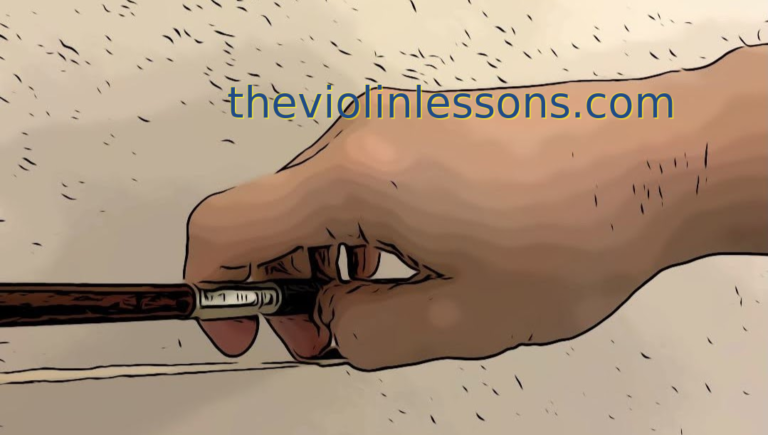
How tightly should you hold a violin bow?
Hold the bow as relaxed as possible and do not press. Remember that the bow is supported by the strings. There is no need to be tense since all fingers must remain free, flexible, and nicely curved. Remember to relax the wrist as well and keep it loose.
I advise to start exercising the bow hold with a pencil or a pen because it is lighter and shorter. You can begin exercising with the bow after practicing with a pencil once your muscles have gotten used to the shape of the bow hold and feel more comfortable.
The bow hold and its relation to sound production
The bow hold is vital to a good quality sound but it is not something isolated. Rather, it is very connected and intertwined with the violin placement, the right hand placement, and the bow arm movement. If you hold a violin bow correctly but something is not working right, there can be a variety of reasons that affect the bow hold and sound production.
Since our body types are different, it is very hard and merely impossible to have one simple solution for everybody. Therefore, everything should be treated as a whole under the supervision of a professional and experienced violinist.
If you liked the article “How to hold a violin bow for beginners” and have more questions please go ahead and email me at [email protected] or book your free trial lesson here.
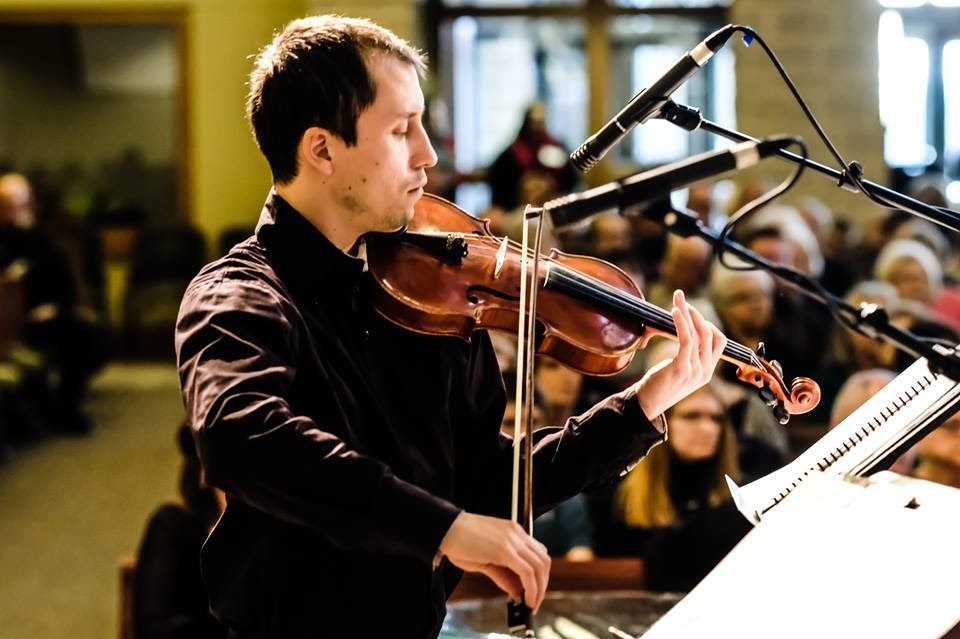
Internationally trained violinist Vlad Evstafiev holds a Master in Music diploma from Glenn Korff School of Music where he was accepted as a Graduate Teaching assistant studying with David Neely, a former student of esteemed Joseph Gingold.Vlad served as a concertmaster of UNL Symphony Orchestra in 2015-2017.
Vlad also holds a Performer Diploma in violin performance from Indiana University, Jacobs School of Music, where he studied with a member of Grammy awarded Pacifica Quartet, Austin Hartmann.
Vlad, originally from Ukraine, received his first Masters of Music diploma in Moscow, Russia, studying with Prof. Golovina, a former student of both, Leonid Kogan and Yuri Yankelevich. He worked professionally with many orchestras including The Bolshoi Theatre and Moscow Central Philharmonic Orchestra under Yuri Simonov. In 2010, Vlad was invited to join San Luis Potosi Symphony Orchestra in Mexico, where he played with them for four years as the assistant principal of second violins as well as in a professional string quartet. At the same time, Vlad worked as a violin teacher at the State of San Luis Potosi School of Music and taught privately as well. Throughout his career, he has had great opportunities to work with such amazing, internationally recognized well-known artists as: Yuri Simonov, Maxim Vengerov, Anton Miller, Ben Folds, Leila Josefowicz, Midori Goto, Joshua Bell, Gil Shaham, Pinchas Zukerman among others
